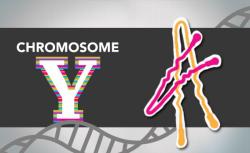My previous post looked at the first human gene ever discovered. In this entry, we’ll look at the other major aspect of genetics, DNA.
DNA encodes information, and despite the splendiferous diversity of life, the universal “alphabet” that DNA uses to jot information down consists of just four letters—A, C, G, and T. (This quartet is also known as the DNA bases, or, individually, as adenine, cytosine, guanine, and thymine.) The bases bind together inside the famous DNA double helix, and they bind together in a particular way. If A appears on one of the helix’s two strands, T must appear opposite it on the other strand (and vice-versa), because A and T molecules fit each other like puzzle pieces. Similarly, if C or G appears on one helix strand, the other letter must appear opposite. (To remember the pairings, notice that angular A and T bond, as do curvaceous C and G.) Because of this complementary A-T and C-G base-pairing, one strand of DNA can serve as a template for copying the other. If one side reads CCGAGT, the other side must read GGCTCA.
Most DNA genes manufacture proteins—that’s their purpose. And although DNA strands can run for millions upon millions of letters, the functional units of DNA are mere triplets, like AAC, or GTA. To make proteins, cells first “transcribe” a DNA triplet into a triplet of RNA, a closely related molecule. They then “translate” each RNA triplet into an amino acid, the building blocks of proteins. Overall, with four DNA letters, there are 64 possible unique triplets (4 x 4 x 4 = 64). That means cells could, in theory, code for up to 64 different amino acids, by assigning one triplet to each amino acid. In reality, cells use only 20 amino acids, so two or more triplets often get assigned to the same amino acid. AAA and AAG both code for the amino acid lysine, for example. This redundancy makes AAA and AAG genetic synonyms.
The four DNA letters are molecules, but because DNA stores and transmits information, you might have noticed a lot of language-related terms being kicked about. It can be hard to even talk about genetics without poaching from linguistics. Beyond translations, synonyms, and letters, there’s also genetic punctuation, prefixes, suffixes, syntax, and my favorite, DNA palindromes.
There are two kinds of DNA palindromes. There’s the traditional, sex-at-noon-taxes type—GATTACATTAG. But because of A-T and C-G base-pairing, DNA produces another, subtler type that reads forward down one strand and backward across the other. Consider the string CTAGCTAG, then imagine what bases must appear on the other strand, GATCGATC. They’re perfect palindromes:
CTAGCTAG
GATCGATC
Palindromes have played an important role in evolution. Many bacteria like to shred each other’s DNA with special wire-cutter enzymes that happen to lock onto palindromes and start snipping. As a result, microbes have learned the hard way to avoid even modest palindromes. Not that we higher creatures tolerate many palindromes either. Consider CTAGCTAG and GATCGATC again. Notice that the first letter within each string can pair-bond with the last (C…G), the second with the penult (T…A), and so on. So if the DNA strand on one side ever disengaged and buckled upward, a kink (or “hairpin”) can form.
GC
AT
TA
…CTAGCTAG… [buckle ->] …CG…
…GATCGATC… …GC…
AT
TA
CG
These hairpins can kill a cell by making DNA impossible to copy or transcribe.
The big exception to the palindromes-are-bad rule is the Y chromosome, the chromosome that makes males male. All humans, male and female, have 23 pairs of chromosomes. Just before cells divide, all these pairs line up along the cellular equator. And in some situations, the chromosomes intertwine their arms and swap genes and DNA, a process called crossing over. Crossing over adds variety to chromosomes, allowing them to acquire better genes, or acquire combinations of genes that work better together.
Just as important, crossing over also helps nature eliminate bad DNA. Imagine two chromosomes, each with one terrible, deadly mutation in a different gene. If they swap segments of DNA just right, both of the bad genes can end up on one chromosome. That chromosome effectively gets sacrificed and disappears (because any embryo that gets it would die), but at least the other chromosome can live on.
XX females can mend all their chromosomes this way, including both Xs. But in males, crossing over can’t eliminate any bum Y-chromosome DNA because the Y in XY males lacks a partner to trade with: If any mutations pop up, they’re stuck there. (The X in XY males also lacks a trading partner, of course, but only temporarily. Male Xs can still cross over in a future generation inside any XX female descendants. Ys never get that chance.) So whenever malignant DNA arose on Y in the past, cells essentially chopped that DNA out and threw it away. This in turn whittled Y down generation by generation. Once a proud chromosome, home to 1400 genes, Y has been reduced to a stub, with just two dozen or so genes today. And some biologists have predicted that Ys will keep getting chopped down and eventually disappear—perhaps making males disappear with them, since the Y houses the DNA needed to make male gonads.
Palindromes, however, may have saved the Y. For various reasons, when cells copy DNA, they sometimes copy out the same sequence twice. Cells also sometimes accidentally flip chunks of DNA ass-backwards (so ABC .. .XYZ becomes ZYX … CBA). Notice that, in tandem, a duplication and inversion create a palindrome. These palindromes can arise on any chromosome, but usually they either get eliminated or ignored.
aergaervaervaervaer
